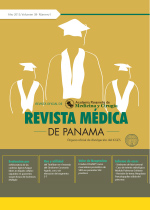Evaluación y Manejo del Cáncer de Pulmón de Células No Pequeñas (CPCNP) Temprano y localmente avanzado: 2do Consenso Nacional de la Sociedad Panameña de Oncología (SPO). (Mesa 4)
Autores/as
DOI:
https://doi.org/10.37980/im.journal.rmdp.2017430Resumen
ResumenDespués de confirmado el diagnóstico histológico de cáncer de pulmón de células no pequeñas (CPCNP) se debe proceder a una evaluación clínica completa. En la evaluación por el grupo multidisciplinario es importante definir de manera inicial si el paciente tiene enfermedad a distancia. De no tenerla, el siguiente paso es definir la presencia de enfermedad ganglionar mediastinal y la capacidad funcional pulmonar del paciente, ya que el tratamiento a seguir dependerá de la evaluación minuciosa de dichas variables.
[Evaluation and Management of Non-small Cell Lung Cancer (NSCLC) Early and locally advanced: 2nd National Consensus of the Panamanian Oncology Society (SPO).]
Abstract
After the histological diagnosis of non-small cell lung cancer (NSCLC) has been confirmed, a complete clinical evaluation should be performed. In the evaluation by the multidisciplinary group it is important to define in an initial way if the patient has distant disease. If not, the next step is to define the presence of mediastinal lymph node disease and the pulmonary functional capacity of the patient, since the treatment to be followed will depend on the detailed evaluation of these variables.
Publicado
Número
Sección
Licencia
Derechos autoriales y de reproducibilidad. La Revista Médica de Panama es un ente académico, sin fines de lucro, que forma parte de la Academia Panameña de Medicina y Cirugía. Sus publicaciones son de tipo acceso gratuito de su contenido para uso individual y académico, sin restricción. Los derechos autoriales de cada artículo son retenidos por sus autores. Al Publicar en la Revista, el autor otorga Licencia permanente, exclusiva, e irrevocable a la Sociedad para la edición del manuscrito, y otorga a la empresa editorial, Infomedic International Licencia de uso de distribución, indexación y comercial exclusiva, permanente e irrevocable de su contenido y para la generación de productos y servicios derivados del mismo. En caso que el autor obtenga la licencia CC BY, el artículo y sus derivados son de libre acceso y distribución.










